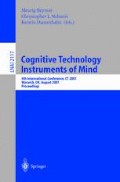Abstract
In this paper, the development and evaluation of a computer based multimedia learning environment capable of supporting group working is reported. The application developed in this study was used in a Further Education (FE) college by tutors and students following a catering course. Learners engaged in the application, performing a range of tasks, based on group working and role playing both on and off-computer. Although no significant difference was found between performance in individual and group work it was found that learners and teachers valued the approach used and performed at least as well on the course than in previous years.
Access this chapter
Tax calculation will be finalised at checkout
Purchases are for personal use only
Preview
Unable to display preview. Download preview PDF.
References
Dealing, R (1997), Higher Education in the learning society: Report of the National Committee of Inquiry into Higher Education, London: NCIHE Publications (HMSO), July
Brown, S. (1998), Reinventing the University, Association for Learning Technology Journal, 6(3), 30–37
Musselbrook, K., McAteer, E., Crook, C., Macleod, H. and Tolmie, A (2000), Learning networks and communication skills, Association for Learning Technology Journal, 8(1):71–79
Crook, K. (1997), Making hypertext lecture notes more interactive: undergraduate reactions. Journal of Computer Assisted Learning, 13, 236–244
Stoney, S. and Wild, M. (1998), Motivation and interface design: maximising learning opportunities. Journal of Computer Assisted Learning, 14,1 40–50.
Hall, W. (1994), Ending the Tyranny of the Button. IEEE Multimedia 1(1):60–68.
Carswell, L., Petre, M., Woodroffe, M. and Stone, D. (1997). What’s possible versus what’s desirable in instructional systems: Who’s driving and is the destination worth the journey? Virtual campus real learning-ALTC-97. University of Wolverhampton, UK, Sept. 15–17.
Ewing, J.M., Dowling, J.D., and Coutts, N. (1999), Learning Using the World Wide Web: A Collaborative Learning Event, Journal of Educational Multimedia and Hypermedia, 8(1):3–22.
Lewin, K. (1948). Frontiers of group dynamics. Human Relations 1:5–42.
English, S and Yazdani, M. (1999), Computer-supported cooperative learning in a Virtual University, Journal of Computer Assisted Learning 15(1):2–13.
Gibbs, G.R. (1999), Learning how to learn using a virtual Learning environment for philosophy, Journal of Computer Assisted Learning, 15:221–231.
Presselsen, B.Z. (1992). A Perspective on the evolution of cooperative thinking. In N. Davidson and F. Worsham (eds). Enhancing thinking through cooperative learning. New York: Teachers College.
Johnson, D. W. a. J., R. (1989). Cooperation and competition: Theory and research, Edna MN: Interaction Book Co.
Sennett, R. and Cobb, J. (1973). The injuries of class. New York: Knopf.
Bruffee, K. A. (1999). Collaborative Learning. 2nd Edition., The John Hopkins University Press, Baltimore and London.
Felder, R. M. and Brent, R. (1994). Cooperative Learning in Technical Courses: Procedures, Pitfalls and Payoffs. NSFDUE Grant DUE-9354379, October, 1994.
Brooks, J. G. and Brooks, M. G. (1993). In search of understanding: The case for Constructivist Classrooms. Alexandria, VA.
Felder, R. M. (1993). Reaching the Second Tier-Learning and Teaching in College Science Education. JCST March–April. 286–290.
De Diana, I. P. F. and White, T. N. (1994). Towards educational superinterface. Journal of Computer Assisted Learning, 10(2):93–103.
Somekh, B. (1996). Designing software to maximise learning. Association for Learning Technology Journal, 4(3):4–16.
Grabinger, S., Dunlap, J. C., Duffield, J. A. (1997). Rich environments for active learning in action: problem-based learning. Association for Learning Technology Journal, 5(2):5–17.
Park, I. and Hannafin, M. (1993). Empirically-based guidelines for the design of interactive multimedia. Education Technology Research and Development, 41:63–85.
Atkins, M. J. (1993). Theories of learning and multimedia applications: An overview. Research Papers in Education, Vol 8, No. 2.
Barker, T., Jones, S., Britton, C. and Messer, D. J. (1997b). The development of tasked based differentiated learning materials for students with learning difficulties and / or disabilities. Proceedings of CAL-97 conference, University of Exeter, March 1997.
Wild, M. (1996). Mental models and computer modelling. Journal of Computer Assisted Learning, 12(1):10–21.
Khan, T. and Yip, Y.J. (1996). Pedagogical principles of case based CAL. Journal of Computer Assisted Learning, 12(3): 172–192.
Stoney, S. and Oliver, R. (1998). Interactive multimedia for adult learners: Can learning be fun? Journal of Interactive Learning Research, 9(1):55–82.
Barker, T., Jones, S., Britton, C and Messer, D. J. (1997b). Creating Multimedia Learning Applications in a Further Education Environment. Technical Report No. 271, University of Hertfordshire, Division of Computer Science, January 1997.
Bloom, B. S. (1956). Taxonomy of Educational Objectives. Book 1, Cognitive Domain, David McKay Company, Inc. New York.
Fitzgerald, G. E., Wilson, B. and Semrau, L. P. (1997). An interactive multimedia program to enhance teacher problem solving skillss based on cognitive flexibility theory: Design and outcomes. Journal of Educational Multimedia and Hypermedia, 6(1):47–76.
Oppenheim, A. N. (1992). Questionnaire design, interviewing and attitude measurement. Pinter, London and Washington.
Reeves, T. C. (1992). Evaluating interactive multimedia. Educational Technology (May) 47–52.
Piaget, J. (1985). The equilibrium of cognitive structures, The central problem in cognitive development. University of Chicago Press, Chicago IL.
Vygotsky, L. (1986). Thought and Language. MIT Press, Cambridge, MA.
Author information
Authors and Affiliations
Editor information
Editors and Affiliations
Rights and permissions
Copyright information
© 2001 Springer-Verlag Berlin Heidelberg
About this paper
Cite this paper
Barker, T., Barker, J. (2001). How Group Working Was Used to Provide a Constructive Computer-Based Learning Environment. In: Beynon, M., Nehaniv, C.L., Dautenhahn, K. (eds) Cognitive Technology: Instruments of Mind. CT 2001. Lecture Notes in Computer Science(), vol 2117. Springer, Berlin, Heidelberg. https://doi.org/10.1007/3-540-44617-6_21
Download citation
DOI: https://doi.org/10.1007/3-540-44617-6_21
Published:
Publisher Name: Springer, Berlin, Heidelberg
Print ISBN: 978-3-540-42406-2
Online ISBN: 978-3-540-44617-0
eBook Packages: Springer Book Archive

